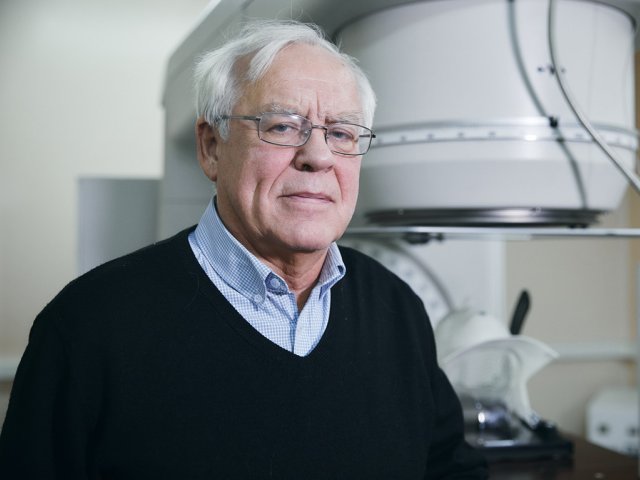Can we learn to predict cancer using the genetic test of saliva or blood and select the treatment that will help to cope with this very type of tumor? Or to find out whether the severe form of this or that viral disease looms ahead? Can one know their immune potential to avoid possible dangers?
The answers to these and many other questions are provided by Aleksandr Grigoryevich Tonevitsky, head of microfluidic systems laboratory at the Shemyakin and Ovchinnikov Institute of Bioorganic Chemistry of RAS, dean at the Biology and Microbiology Faculty of Higher School of Economics, RAS correspondent member, doctor of biology, professor.
– Aleksandr Grigoryevich, what are the microfluidic systems that you study?
– The very name of them contains the answer to your question. These are the systems with microfluid flowing along them. The term is derived from two Greek roots – micro meaning small and fluid meaning flowing. On the one hand, the successful development of microfluidics is related to achievements in physics, when new material and opportunities emerge, as the flow of liquid along the capillary tubes is complex enough process. It means high speeds, crossing of flows, etc. That is why cutting-edge methods are required – from the fields of engineering, mechanics and physics.
The second story is about good knowledge of physiology and biology in general. After all, my area of research deals with biology and engineering sciences to a lesser extent. I specialize in molecular physiology studying the function of these or those cells and organoids based on them.
– Why is it important?
– On the one hand, we see the rapid development of pharmacology, and it becomes clear that the old or classic methods of testing drugs on animals are good, yet do not fully meet the requirements of the present day. Let u take monoclonal antibodies for instance. They identify these or those cell receptors of human organism. Neither mice nor rabbits and pigs have such proteins. Even monkeys do not always have them.
Obviously, the monkeys have always been the classic final objects. However, serious problems, both ethical and economic, related to these experiments promote the switchover to human cell and organs.
Here, microfluidic systems with some number of human cells represented in them come in. For instance, it may be the intestinal tract or blood-brain barrier on a chip; placenta on chip which is harder to get; or spheroids: liver, brain or spleen on chip.
– What do you mean by brain on chip, spleen on chip?
– What kind of a thing is the chip? It is not the chip that we have got accustomed to, the one related to electronics.
– And microchipping that media intimidate us with.
– Sure, all of us have undergone microchipping a bit. However, this chip is different. It is a plastic cell or box with dimensions of about 5X5 mm containing spheroids. Spheroids are balls containing these or those cells. The dimensions of spheroid depend upon the oxygen diffusion rate. That is why a thousand, two thousand balls determine the size of spheroid. Usually, it amounts to about 100 microns. Such a spheroid floats in the said box.
Feed medium is supplied to this box; the size of channel is lower than the one of spheroids, so they live there in peace. There are variants when they live in this feed medium or matrix – the structure looking like jellied meat – where they are rather motionless, so it is easier to work with them.
All these structures may be stratified or multilayered. There is a box inside, which is divided by a semitransparent membrane. The membrane has pores 2-10 microns in size. They may be either transparent or not and made of different materials. These or those cells are present on either one or the other surface.
For instance, placenta on chip means endothelium and trophoblasts. Intestinal tract on chip means just single-layer epithelium of intestinal tract. The double-layer chamber features the flow of liquid, both from top and bottom. It allows for seeing both apical and basal membrane, as well as studying the behavior of cells.
– What do these studies yield in practice?
– A lot. In fact, all these are tumor cells having virtually come back to their native state in certain conditions. That is why, good fundamental science is required to understand what, say, hepatocytes are like. These are cells containing this or that set of cytochromes. What should we know it for? It is because we are worried about certain drugs making it into the human organism, as well as their metabolites which accumulate in liver in the first turn. Here, it is again great that human liver cells have the set of these very cytochromes and other ferments very similar to human ones. It is what we cannot get from animals.
Thus, we model the behavior of certain human cells in response to this or that impact.
– And look what impact certain drugs make on tissue and organs, right?
– Yes, sure. The story of this success achieved with the use of microfluidic systems is on the level of research so far. The regulatory document on using these systems in preclinical studies has just been drawn up in Europe and America.
– What stage is this process at in Russia?
– Also preclinical one, yet we are working with all might. The patents, scholar papers and cooperation with these or those groups in Europe show that we are well up to expectations. The instruments and tools that we work with are of domestic origin. They are successfully used by our partners in Europe, Germany in the first turn. These are liver, brain, cardiomyocyte, lungs, etc. All of them are in one contour, so we can examine the effect of a certain drug which makes it into liver first, while its metabolites later spread all over the organism. These are very good system that allow for understanding what effect a certain drug would produce on human organism at the stage of preclinical studies. Whether it is efficient and safe. Cases are described when the scientists have managed to detect toxicity at this stage, which is very important, as it allows us to avoid various adverse events for volunteers.
– Is it possible to refuse from experiment involving animal completely and replace them with such smart systems?
– This question is being discussed, first of all its economic and ethical aspects. Shall we replace the majority of experiments on, say, mice with such systems? The process is quick and standard. However, the method cannot be universal. It may be very effective and sought-after for some classes of medications, yet not for all of them perhaps. That is why, the issue is debated. We take part in some international consortiums which discuss the parallel use and regulations of applying microfluidic systems with European regulators and FDA.
– Can such systems be used for selection of treatment?
– Yes, it is one more good opportunity – using these systems for individual selection of immune therapy. For that, we take a piece of tumor of the fourth stage as a rule, a surgical specimen. Needle biopsy is used in case of prostate cancer for instance. Within two or three weeks, we can grow a reasonable number of such balls from the piece we have, test the drugs, and find out which of them will work. Our key project today deals with rectal cancer. It is required for tumors with a choice of cytostatic agents. Now the protocol is being drawn comparing the clinical application with our laboratory one. We see very interesting results.
– What other kinds of tumors do you work with?
– Prostate and breast cancer. In all cases, we model the tumor’s response to cytostatic agent to learn which agent does poor work, what should not be prescribed, etc. It is the most important thing, when there is a choice.
– I know that you also deal with the topic of new coronavirus infection. Tell me, please, about this research.
– To be exact, we deal with bioinformatics. In fact, it I the continuation of our research devoted to building classifiers, when we analyze the expression of this or that gene and try to predict the severity, as well as chose the treatment and define the prospects for therapy on the basis of biopsy test. We built such classifiers for the breast and rectal cancer in the first turn.
Later, it turned out that the method we used for analyzing cell phenotypic characteristics are suitable in case of viral infections as well. For COVID, we merely switched over to T-cell response knowing that it was the key to success in combating the infections.
T-cell response is determined by first-class histocompatibility antigens. These are six molecules that each of us has. Knowing that these six molecules may bind with viral peptides, as well as being aware of first-class histocompatibility antigens’ genetics, we tried to predict the progress of disease. These results are patented and published. It has turned out that, yes, it is possible, though there are about a thousand variants for each gene, while the virus generates about 15,000 peptides.
– How did you conduct these studies?
– Jointly with my colleagues from the Pirogov Russian National Research Medical University, we have sequenced a substantial quantity of patients’ samples, as well as obtained additional information in cooperation with colleagues from Spain. It is worth noting that the process was not easy. It is good that we have vaccine today, and reasonable people have no doubt about vaccination.
The next interesting moment that we study today deal with mutants of virus. We have prepared database that allows for analyzing how the mutation alters the T-cell immunity characteristics.
Besides, we have developed methods assessing the state of T-cell immunity itself. We can confirm our theoretical studies with analysis. First data has been obtained as to how the T-cell immunity of a person who has gone through the disease changes in six months, and how its individual properties determine the behavior and further protection against COVID.
– This information is very important, as many people doubt the efficiency of vaccination. These arguments will help persuade them.
– Everyone should get vaccinated. It is a separate story why people do not want to do it. Any arguments are good here. A for our algorithm, the Spaniards whom we work with are happy about the possibility to test it. Our algorithm has predicted the risk groups in Spain even better than in Moscow.
–Why so?
– It must be because Moscow is a more heterogeneous city. For instance, my colleagues from Germany say: “Look, we are not interested in these things. We have adopted a strategy aimed at 100% vaccination.” Moreover, this decision gives rise to neither doubts nor protests. Unfortunately, it does not work out this way in Russia so far.
The next area we work with lies in post-COVID complications, and our algorithm is again in demand. These complications are met in 30% of patient having gone through the disease minimum.
– Including those who have gone through the mild form, as far as I know.
– Yes. Most often, it is myocarditis for young patients. Unfortunately, the outbreak of nosological problems is expected in one, two, three years. Neurological complications as well. They are very hard to assess. While it is easy to diagnose myocarditis, here we have serious problems.
The third and very large group of patients including people at elderly age demonstrates cognitive complications and memory loss. We are afraid of talking about neurodegenerative complications so far, but cognitive changes are obvious. This is what the scholars of the whole world discuss in our leading and clinical journals.
We suspect that the severity of these complications must be related to immune system behavior among other things, while the immune system behavior can be predicted accurately enough by examining just six genes, and we can do it.
– Did you try to predict such things for some of your employees?
– Certainly, we did, yet for the physicians we work with instead of employees. We love and try to help them, especially the ones working in red zones. They passed our first tests back in February, and we obtained important information.
– How are these tests taken? Blood tests?
– It is targeted sequencing of a small number of genes. It is not even necessary to donate blood for it. Saliva is quite enough. We need the patient’s DNA.
We know that the very T-cell receptor recognizing the peptide plays the major role. There are T-cell receptor and T-cell immunity tests, yet can we predict it? The leading world laboratories are trying to do it.
What else makes T-cell immunity interesting? We have COVID today and will have something else tomorrow. We do not change, while viruses are changing. We would like to know our own resources, and whether we can activate them somehow to be prepared for new challenges. We have recently started to study this problem as well.
Aleksandr Grigoryevich Tonevitsky, head of microfluidic systems laboratory at the Shemyakin and Ovchinnikov Institute of Bioorganic Chemistry of RAS, dean at the Biology and Microbiology Faculty of Higher School of Economics, RAS correspondent member, doctor of biology, professor.
Interviewer: Natalia Leskova
Photo: Andrey Luft/Scientific Russia



































